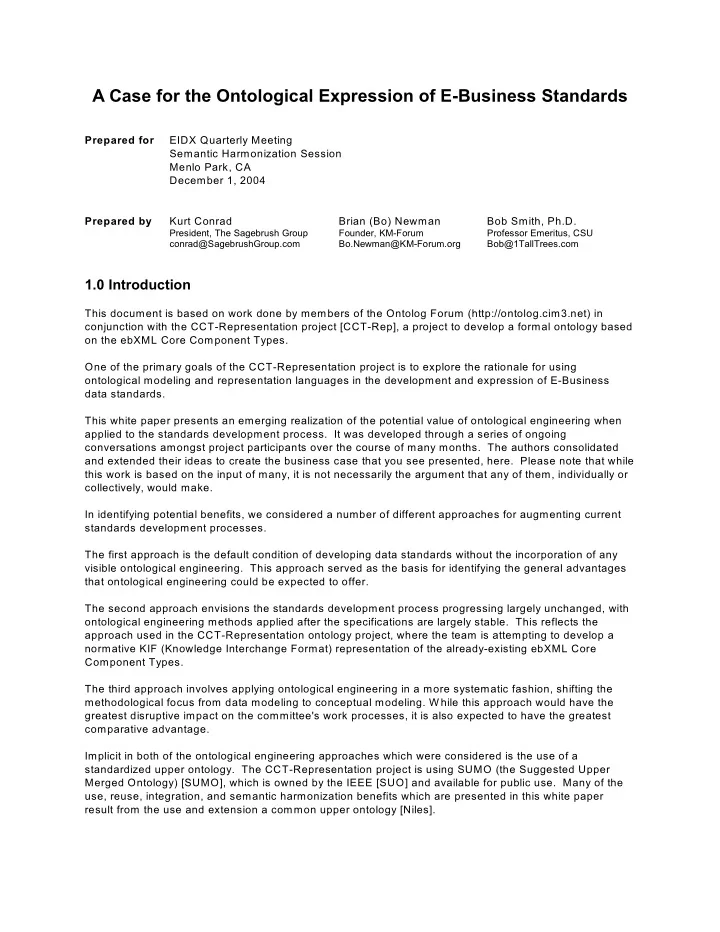

A Case for the Ontological Expression of E-Business Standards Prepared for EIDX Quarterly Meeting Semantic Harmonization Session Menlo Park, CA December 1, 2004 Prepared by Kurt Conrad Brian (Bo) Newman Bob Smith, Ph.D. President, The Sagebrush Group Founder, KM-Forum Professor Emeritus, CSU conrad@SagebrushGroup.com Bo.Newman@KM-Forum.org Bob@1TallTrees.com 1.0 Introduction This document is based on work done by members of the Ontolog Forum (http://ontolog.cim3.net) in conjunction with the CCT-Representation project [CCT-Rep], a project to develop a formal ontology based on the ebXML Core Component Types. One of the primary goals of the CCT-Representation project is to explore the rationale for using ontological modeling and representation languages in the development and expression of E-Business data standards. This white paper presents an emerging realization of the potential value of ontological engineering when applied to the standards development process. It was developed through a series of ongoing conversations amongst project participants over the course of many months. The authors consolidated and extended their ideas to create the business case that you see presented, here. Please note that while this work is based on the input of many, it is not necessarily the argument that any of them, individually or collectively, would make. In identifying potential benefits, we considered a number of different approaches for augmenting current standards development processes. The first approach is the default condition of developing data standards without the incorporation of any visible ontological engineering. This approach served as the basis for identifying the general advantages that ontological engineering could be expected to offer. The second approach envisions the standards development process progressing largely unchanged, with ontological engineering methods applied after the specifications are largely stable. This reflects the approach used in the CCT-Representation ontology project, where the team is attempting to develop a normative KIF (Knowledge Interchange Format) representation of the already-existing ebXML Core Component Types. The third approach involves applying ontological engineering in a more systematic fashion, shifting the methodological focus from data modeling to conceptual modeling. W hile this approach would have the greatest disruptive impact on the committee's work processes, it is also expected to have the greatest comparative advantage. Implicit in both of the ontological engineering approaches which were considered is the use of a standardized upper ontology. The CCT-Representation project is using SUMO (the Suggested Upper Merged Ontology) [SUMO], which is owned by the IEEE [SUO] and available for public use. Many of the use, reuse, integration, and semantic harmonization benefits which are presented in this white paper result from the use and extension a common upper ontology [Niles].
2.0 Expected Qualitative Impacts A basic lifecycle model was used to inventory the potential benefits of applying ontological engineering methodologies during the development of standards: Development and Maintenance Review and Approval Publishing Decision to Adopt Implementation In addition, we also identified a number of benefits that are "transcendent" and impact multiple portions of the lifecycle. 2.1 Development and Maintenance Impacts Standards development is hard work. Most standards bodies work harder than they have to. Not only is getting people to agree often difficult, but getting them to use the same terms and mean the same thing when they use them has been the downfall of many a fine standards body. From an ontological perspective, the basis of any robust data standard is a shared conceptualization: agreement on an underlying conceptual model which is reflected in the resulting specifications. Most of us are familiar with situations where the committee could not identify the core, underlying issues and/or reach needed agreements, resulting in standards that contained "land mines" that undermined the quality of the standard. It is expected that the use of ontological engineering approaches would lower overall cost and time to deliver standards. Ontological engineering can illuminate ontological gaps and misalignments among committee members and other interests. This should enable them to accelerate agreement on key terms to more efficiently communicate, in general, and identify and resolve the truly fundamental issues associated with the targeted standard. Ontological engineering can also be expected to improve the stability of the resulting standards through a number of mechanisms. First, better identification and resolution of critical issues can be expected to improve the stability of the resulting standard, directly. Second, an improved ability to balance competing interests and reduce the tendency to couch implicit policies, hidden agendas, and unaligned operational models in inherently ambiguous language will improve the quality and transparency of committee’s decision making process. Third, the development of ontological formalizations will allow the semantics of the specification to be expressed in a more complete fashion, further reducing ambiguity and improving knowledge transfer from the committee to downstream communities. Expressing specifications as formalized ontologies will also enable the standards bodies to make use of more advanced tools that can automatically perform various quality and constancy checks, create conforming alternate renderings, reduce drudgery, and further improve speed and quality [Denno]. As standards are subject to a wide variety of potentially disruptive interpretations and change vectors, the introduction of ontological engineering can be expected to help, not only with the initial development of the standard, but also in its downstream maintenance. A Case for the Ontological Expression of E-Business Standards Page 2
Recommend
More recommend